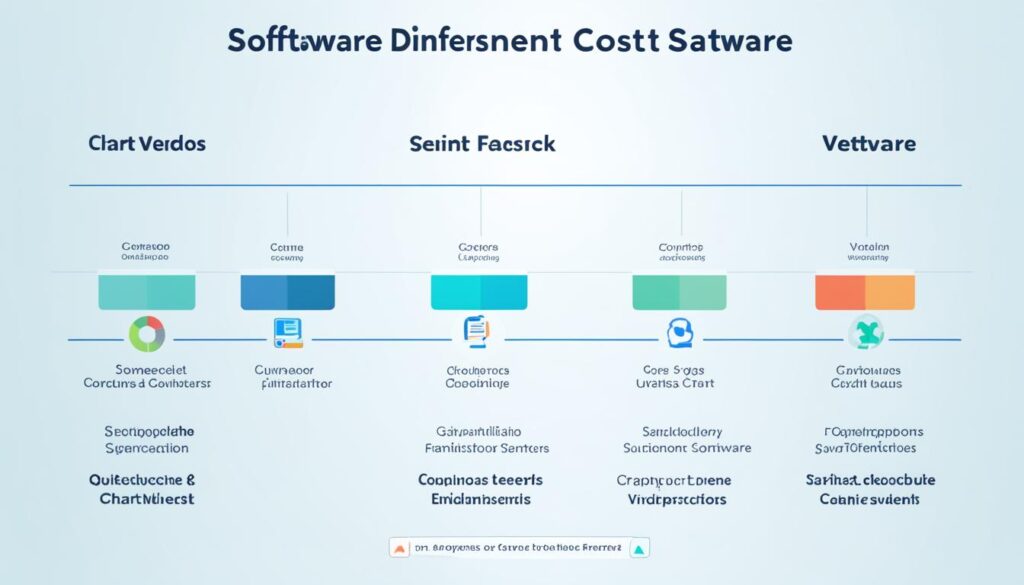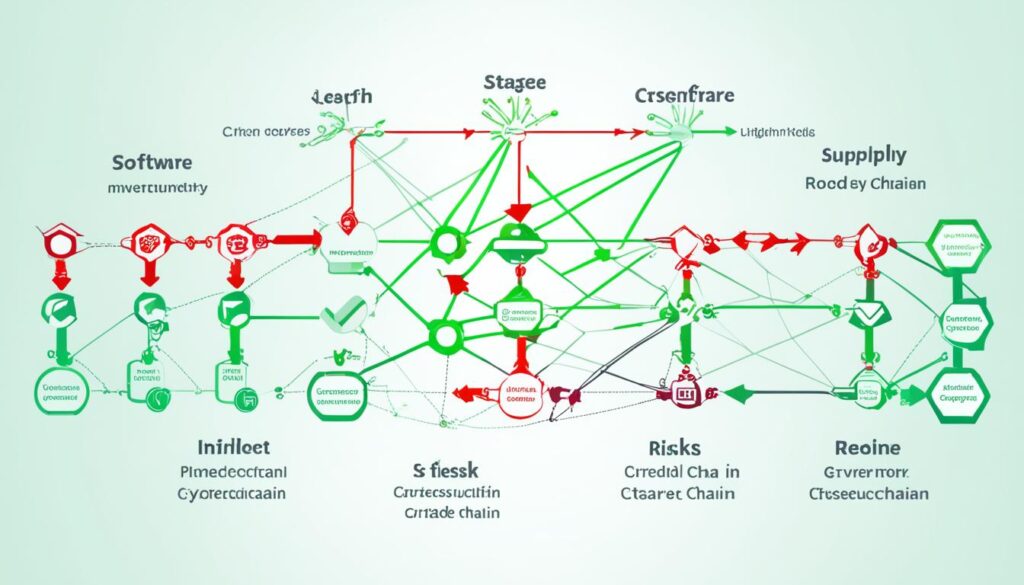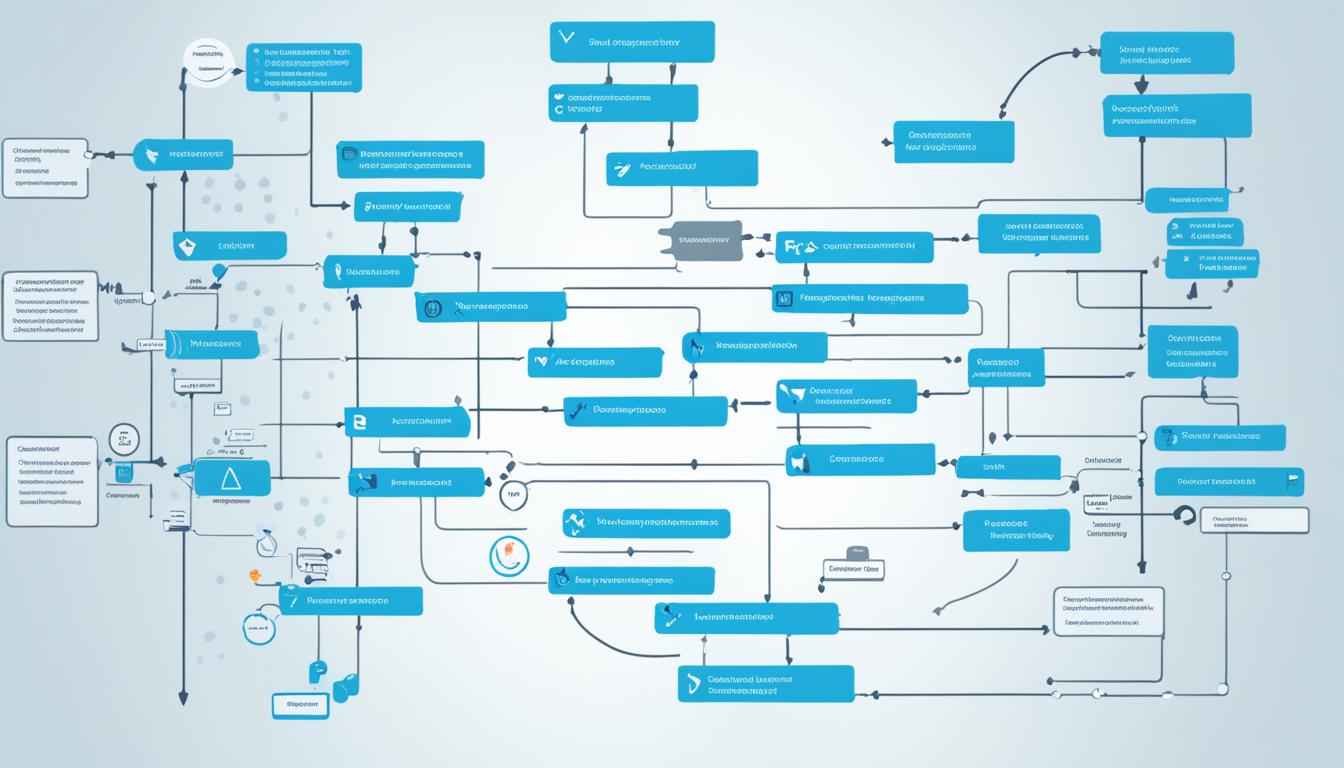The software acquisition lifecycle is a detailed, multi-step journey for organizations. They use it to get, set up, and oversee crucial digital tools for their work. This full process includes everything from first seeing a need to checking how the software works after it’s in place. It makes sure all software bought is useful for the business. The software purchasing cycle is more than just buying; it’s a deep search to fit new software with big business goals.
People looking to use these tools and ways of doing things learn that a careful, informed approach helps a lot. It makes the buying process smoother and protects their organizations from usual software troubles. Knowing the whole software buying cycle well helps them know when to upgrade. It also helps them start using new things that could really help their work get better and more efficient.
Key Takeaways
- Grasp the essentials of the software acquisition lifecycle to make informed decisions during software procurement.
- Recognize the impact of a thorough software purchasing cycle on the long-term effectiveness of technology investments.
- Utilize the software procurement process to align software purchases with the strategic objectives of the organization.
- Identify the key stages of the software acquisition lifecycle to effectively manage the transition from selection to implementation.
- Employ best practices to evaluate and engage with software vendors for successful software integrations.
Understanding the Software Acquisition Lifecycle and Its Importance
Getting new software is a complex and key process that shapes how well an organization performs and stays secure. As businesses grow, having a smart software sourcing strategy becomes key. This process, called the software acquisition lifecycle, looks closely at many factors. It makes sure the chosen software fits the organization’s goals and needs well.
Defining the Software Acquisition Lifecycle
The software acquisition lifecycle is a plan that helps organizations through the tough process of picking, getting, and adding software solutions. It includes planning, software vendor evaluation, buying, setting up, and taking care of the software. This makes sure each part leads to getting software that fits what the company needs.
The Role of Workforce Development Solutions Like VAO
Programs like the Virtual Acquisition Office (VAO) are vital in the software buying lifecycle. VAO gives people powerful tools like ways to work together, templates that follow the best industry practices, and news on rules. These help teams understand the lifecycle well. This is very useful when gathering needs and evaluating software vendors.
Key Phases: Needs Analysis and Environmental Scans
Figuring out what the company needs is one of the first and most important steps. This part involves looking deeply at what the company needs now and in the future. It makes sure the software chosen will be up to the challenge.
Looking at the market and checking out available options is also key. This is done by looking carefully at what each option offers in terms of use, safety, and how well it will work with other systems. This detailed process helps pick the best vendors. It also strengthens the software sourcing strategy. It ensures the chosen software fits into the company smoothly.
| Phase | Activities | Outcomes |
|---|---|---|
| Needs Analysis | Assess current systems, identify gaps, forecast future needs | Detailed requirements document |
| Environmental Scans | Market research, competitor analysis, technology trends review | Comparative market insights |
| Software Vendor Evaluation | Review vendor history, assess product features, evaluate customer support | Shortlist of qualified vendors |
| Software Sourcing Strategy | Develop procurement plan, define evaluation criteria, engage stakeholders | Strategic sourcing plan |
Understanding the software acquisition lifecycle is vital for successful implementation. It shapes how companies approach buying software. This leads to smarter investments and a stronger tech base.
Strategies for Effective Software Sourcing and Vendor Evaluation
Finding the right technology is key to a company’s success today. An effective strategy for choosing software and vendors is essential. It involves understanding your organization’s needs and analyzing the market. This plan helps reduce risks and maximize benefits. It influences not just the first choice but also the ongoing software licensing negotiation. This can affect the company’s finances over time.

Conducting Comprehensive Needs and Problems Analysis
The process starts by looking at current challenges and what the system needs to do. It’s important to listen to IT professionals and end-users. This creates a plan that meets technical and user needs. A deep understanding ensures the search for a software vendor evaluation is focused and effective.
Environmental Scans: Benchmarking and Learning from Other Institutions
After setting benchmarks, companies look at the market through environmental scans. This involves looking at potential software and learning from others’ experiences. It helps to compare and understand how similar solutions worked elsewhere. This is crucial for improving software sourcing strategies.
Accessibility, Security, and Functionality Considerations in Vendor Evaluation
When assessing vendors, consider accessibility, security, and functionality. A good software solution is easy to use for everyone. It must have strong security to protect against threats. And, its features should solve your specific problems. These factors are key in software licensing negotiation. They affect the contract details and how useful the software will be long-term.
By following these steps, organizations can find software that meets their immediate needs. They can also arrange for ongoing support. This ensures the software remains useful for as long as it’s needed.
Best Practices in Software Licensing Negotiation and Contract Management
When acquiring software, smart software contract management and detailed software implementation planning are key. They help any organization succeed. Legal and financial aspects guide a software’s life. This makes it crucial to negotiate the best terms possible.
Understanding all costs of software licensing is your first step. This knowledge allows effective negotiation for discounts and long-term savings. Software implementation planning needs a look ahead into resource use, schedules, and what different departments need. This ensures smooth software fitting into your operations.
A central place to keep track of renewal times and deadlines eases contract management. Good software contract management means talking clearly with vendors. This keeps everyone on the same page about the contract. And it helps maintain a good relationship, vital for solving any software issues.
Dealing with key contract parts like liability, warranties, and indemnity is critical. You must protect your legal rights without harming the partnership. Here’s how to approach these crucial areas:
- Evaluate total ownership cost against upfront fees to see long-term impacts.
- Match software needs with what your organization aims to do for better relevance and effect.
- Be clear on use, support, upkeep, and update terms to avoid surprises.
- Check software service levels and penalties for not meeting them to ensure performance.
The skill in negotiation and strict software contract management are connected. Done well, they lead to successful software implementation planning and software management. As software changes, so should our agreement and management strategies.
Software Acquisition Lifecycle: Implementation Planning and Integration Testing
The core of software acquisition is found in software implementation planning and software integration testing. These steps take a concept and turn it into a tool that works well at work. They decide how well the software will do in the long run within an organization.
Developing a Detailed Project Plan: Timelines and Resource Allocation
Creating a strong project plan starts with detailed software implementation planning. It involves careful planning of timelines and how people and money are used. This helps the software start smoothly and avoids problems when it’s introduced.
Planning isn’t just about the money. It also includes training, support, and fitting the new software with existing systems. It’s crucial to explain these parts well in your plan:
- Roles and responsibilities of the project team
- Milestones and deadlines
- Training sessions for end users
- Technical support strategies during and post-implementation
Ensuring Successful Implementation through Proper Planning
For software acquisition to work, every step of setting it up must be planned. This means not just installing it, but also setting up things like system checks and software integration testing. Good planning makes sure the software works well with what’s already there and makes things better.
Importance of Rigorous Software Integration Testing
Software integration testing is key to finding problems early. It lets organizations test the software like it’s really being used. This helps find any parts that don’t work well together or other issues.
Integration testing is very important:
It’s what proves if the software can really do what it’s supposed to in real life, not just in theory.
| Integration Testing Phase | Objective | Expected Outcome |
|---|---|---|
| Unit Testing | Examination of individual components for correctness. | Verification of component functionality. |
| System Testing | Validation of entire system’s adherence to requirements. | Confirmation that the system meets specified standards. |
| Interface Testing | Checking the data flow between modules. | Seamless interaction between software components. |
| User Acceptance Testing (UAT) | Ensure software meets user needs and usability standards. | User-approved product ready for deployment. |
In the end, the combination of thorough software implementation planning and software integration testing is vital. It ensures a successful move from buying to using the software every day. This gives organizations tools that are not only new but also make workflows better.
Managing Cybersecurity Risks Throughout the Software Purchasing Cycle
Today’s organizations face complex software supply chain risks. It’s clear that cybersecurity risks in the supply chain are serious and can’t be overlooked. The close links in software supply chains need a strong strategy to handle all potential risks. Traditional methods to protect purchases no longer work well against modern cyber threats.

Using a risk-based strategy, like the Software Assurance Framework (SAF) or A-SQUARE, helps manage cybersecurity risks. These frameworks show how to focus efforts where they’re most needed to protect the buying process.
Using risk-based cybersecurity frameworks during software buying isn’t just careful. It’s essential for companies wanting to protect their software investments.
Here are steps to use these methods:
- Find potential cybersecurity risks in the software supply chain.
- Compare these risks with industry benchmarks and prior data.
- Put in place the right protections, based on SAF and A-SQUARE best practices.
- Keep reviewing and updating cybersecurity methods as threats change and new risks appear.
By adopting these advanced cybersecurity steps, organizations can lower risks from vendors and third-party services. This leads to a safer and more dependable software supply chain.
Leveraging Cybersecurity Frameworks for Enhanced Acquisition Security
In the digital world we live in, Cybersecurity Practices for Acquisition are crucial. Organizations must have strong systems to protect their software buys. They should use established cybersecurity frameworks to handle risks during the buying process. The Software Assurance Framework (SAF) is one key plan that offers detailed steps for better security.
By adding these frameworks to the acquisition plan, companies can better watch and improve their defenses. This step is important when getting new software, as unguarded weaknesses could be attacked. With these strong cybersecurity steps, firms can feel secure in every software buying phase while controlling risks.
Below is a table showing how the SAF can be used at various software buying stages:
| Acquisition Phase | Cybersecurity Practices | Outcome |
|---|---|---|
| Planning | Review and integrate SAF pre-procurement guidelines | Structured approach to identifying security needs early on |
| Procurement | Apply SAF vendor assessment criteria | Enhanced vendor selection with a focus on security |
| Implementation | Adherence to SAF deployment strategies | Secure software integration into existing systems |
| Maintenance | Ongoing SAF compliance checks | Continuous protection against evolving cybersecurity threats |
Using the SAF well improves security steps and shows a firm’s dedication to cybersecurity. It’s a key part of a broad plan that includes Cybersecurity Practices for Acquisition to create a safer software space.
These frameworks help companies go beyond just meeting basic rules and build a culture of ongoing cybersecurity growth. As digital challenges increase, such efforts are key for companies to keep their trust and integrity in their fields.
Adopting Proven Methods for Security Requirements and Tradeoff Analysis
In the world of software buying, a big issue is how to set up and match security rules. Security requirements prioritization is not just an extra thing for companies, it’s a key part of staying safe. When getting new software, it’s really important to use smart acquisition cybersecurity methods. Using these methods means you can defend against threats before they happen and after they’re found. A good method that many fields like is A-SQUARE, which simplifies how to define what security you need into steps that are clear and can be judged.
This detailed system takes people through a seven-step journey. It starts by agreeing on what words mean and goes to analyzing what security goals mean for what a company owns. A-SQUARE helps in breaking down and looking closely at what security you need. It helps you do tradeoff analyses well. You look at what you gain and lose right away, but also what it means for the long run. Thinking this deeply makes sure security is a strong support during the whole process of getting software.
The big plus of using A-SQUARE is it helps businesses make choices that fit their own needs for security. With digital threats getting worse all the time, using complete acquisition cybersecurity methods like A-SQUARE could be what keeps your software safe. It makes you think about every part of security. This makes a strong defense against the many dangers in the growing online world.



